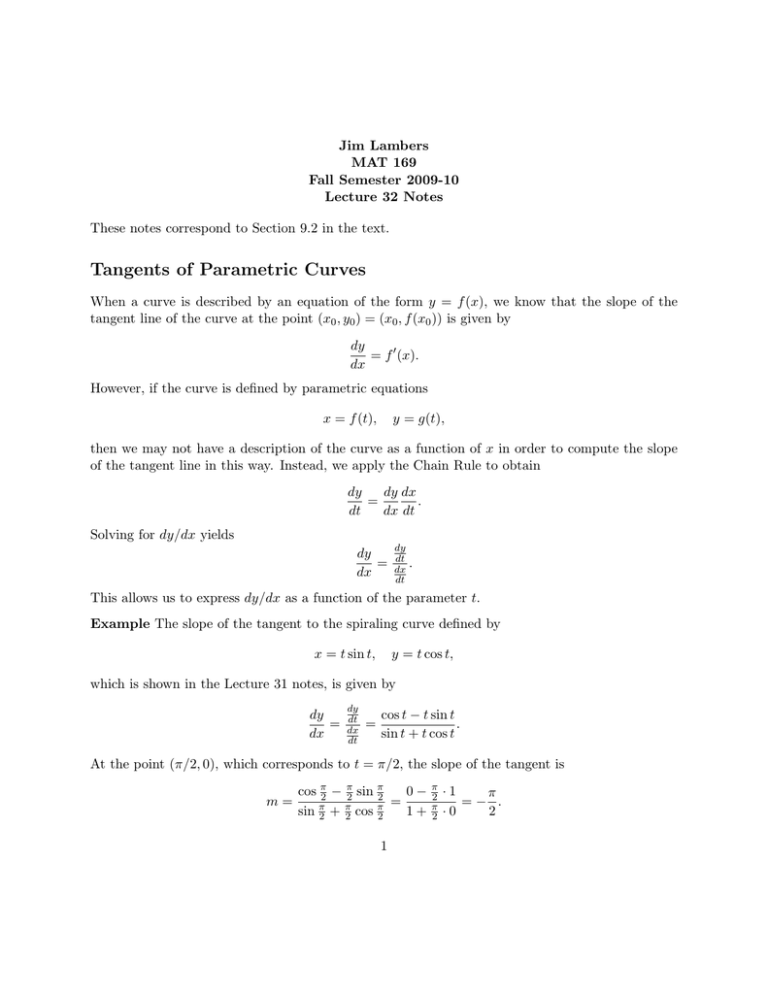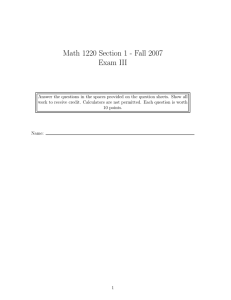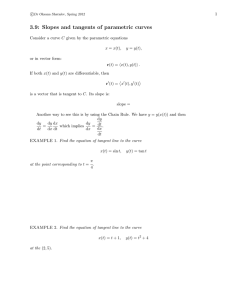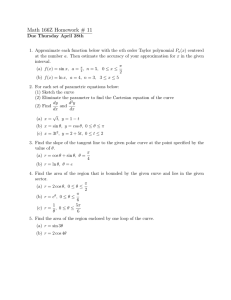Tangents of Parametric Curves
advertisement

Jim Lambers MAT 169 Fall Semester 2009-10 Lecture 32 Notes These notes correspond to Section 9.2 in the text. Tangents of Parametric Curves When a curve is described by an equation of the form 𝑦 = 𝑓 (𝑥), we know that the slope of the tangent line of the curve at the point (𝑥0 , 𝑦0 ) = (𝑥0 , 𝑓 (𝑥0 )) is given by 𝑑𝑦 = 𝑓 ′ (𝑥). 𝑑𝑥 However, if the curve is defined by parametric equations 𝑥 = 𝑓 (𝑡), 𝑦 = 𝑔(𝑡), then we may not have a description of the curve as a function of 𝑥 in order to compute the slope of the tangent line in this way. Instead, we apply the Chain Rule to obtain 𝑑𝑦 𝑑𝑦 𝑑𝑥 = . 𝑑𝑡 𝑑𝑥 𝑑𝑡 Solving for 𝑑𝑦/𝑑𝑥 yields 𝑑𝑦 = 𝑑𝑥 𝑑𝑦 𝑑𝑡 𝑑𝑥 𝑑𝑡 . This allows us to express 𝑑𝑦/𝑑𝑥 as a function of the parameter 𝑡. Example The slope of the tangent to the spiraling curve defined by 𝑥 = 𝑡 sin 𝑡, 𝑦 = 𝑡 cos 𝑡, which is shown in the Lecture 31 notes, is given by 𝑑𝑦 = 𝑑𝑥 𝑑𝑦 𝑑𝑡 𝑑𝑥 𝑑𝑡 = cos 𝑡 − 𝑡 sin 𝑡 . sin 𝑡 + 𝑡 cos 𝑡 At the point (𝜋/2, 0), which corresponds to 𝑡 = 𝜋/2, the slope of the tangent is 𝑚= cos 𝜋2 − 𝜋2 sin 𝜋2 0− 𝜋 𝜋 𝜋 = sin 2 + 2 cos 2 1+ 1 𝜋 2 𝜋 2 ⋅1 𝜋 =− . ⋅0 2 From the point-slope form of the equation of a line, we see the equation of the tangent line of the curve at this point is given by 𝜋( 𝜋) 𝑦−0=− 𝑥− . 2 2 □ We know that a curve defined by the equation 𝑦 = 𝑓 (𝑥) has a horizontal tangent if 𝑑𝑦/𝑑𝑥 = 0, and a vertical tangent if 𝑓 ′ (𝑥) has a vertical asymptote. For parametric curves, we also can identify a horizontal tangent by determining where 𝑑𝑦/𝑑𝑥 = 0. This is the case whenever 𝑑𝑦/𝑑𝑡 = 0, provided that 𝑑𝑥/𝑑𝑡 = 0, thus excluding the case where 𝑑𝑦/𝑑𝑥 is the indeterminate form 0/0. Similarly, the tangent line is vertical whenever 𝑑𝑥/𝑑𝑡 = 0, but 𝑑𝑦/𝑑𝑡 ∕= 0. Example Consider the unit circle, which can be parametrized by the equations 𝑥 = cos 𝑡, 𝑦 = sin 𝑡, 0 ≤ 𝑡 < 2𝜋. The slope of the tangent at any point on the circle is given by 𝑑𝑦 = 𝑑𝑥 𝑑𝑦 𝑑𝑡 𝑑𝑥 𝑑𝑡 = cos 𝑡 = − cot 𝑡. − sin 𝑡 A horizontal tangent occurs whenever cos 𝑡 = 0, and sin 𝑡 ∕= 0. This is the case whenever 𝑡 = 𝜋/2 or 𝑡 = 3𝜋/2. Substituting these parameter values into the parametric equations, we see that the circle has two horizontal tangents, at the points (0, 1) and (0, −1). A vertical tangent occurs whenever sin 𝑡 = 0, and cos 𝑡 ∕= 0. This is the case whenever 𝑡 = 0 or 𝑡 = 𝜋. Substituting these parameter values into the parametric equations, we see that the circle has two vertical tangents, at the points (1, 0) and (−1, 0). □ It is important to note that unlike a curve defined by 𝑦 = 𝑓 (𝑥), a point on the curve may have more than one tangent line, because a parametric curve is allowed to intersect itself. Example Consider the curve defined by the parametric equations 𝑥 = 𝑡2 , 𝑦 = (𝑡2 − 4) sin 𝑡. This curve has two tangents at the point (𝜋 2 , 0). To see this, we first note that 𝑥 = 𝑡2 = 𝜋 when √ 𝑡 = ± 𝜋. Substituting these values into the equation for 𝑦, we obtain 𝑦 = 0, since sin 𝑡 = 0 when 𝑡 = ±𝜋. Therefore, there are two distinct parameter values corresponding to this point on the curve. Next, we must compute 𝑑𝑦/𝑑𝑥 for both values of 𝑡. We have 𝑑𝑦 = 𝑑𝑥 𝑑𝑦 𝑑𝑡 𝑑𝑥 𝑑𝑡 = 𝑡2 − 4 (𝑡2 − 4) cos 𝑡 + 2𝑡 sin 𝑡 = sin 𝑡 + cos 𝑡. 2𝑡 𝑡 2 Substituting 𝑡 = −𝜋 yields 𝑑𝑦 (−𝜋)2 − 4 𝜋2 − 4 = sin(−𝜋) + cos(−𝜋) = ≈ 1.8684. 𝑑𝑥 −𝜋 𝜋 On the other hand, substituting 𝑡 = 𝜋 yields 𝑑𝑦 𝜋2 − 4 𝜋2 − 4 = sin 𝜋 + cos 𝜋 = − ≈ −1.8684. 𝑑𝑥 𝜋 𝜋 The curve is illustrated in Figure 1. □ Figure 1: Graph of the parametric curve 𝑥 = 𝑡2 , 𝑦 = (𝑡2 − 4) sin 𝑡. In order to graph curves, it is helpful to know where the curve is concave up or concave down. For a curve defined by 𝑦 = 𝑓 (𝑥), this is determined by computing its second derivative 𝑑2 𝑦/𝑑𝑥2 = 𝑓 ′′ (𝑥) and checking its sign. For a parametric curve, we can compute 𝑑2 𝑦/𝑑𝑥2 in the same way as 𝑑𝑦/𝑑𝑥, by using the Chain Rule. First, we note that ( ) 𝑑2 𝑦 𝑑 𝑑𝑦 = . 𝑑𝑥2 𝑑𝑥 𝑑𝑥 3 Then, from the Chain Rule, 𝑑 𝑑𝑡 ( 𝑑𝑦 𝑑𝑥 ) 𝑑 = 𝑑𝑥 ( 𝑑𝑦 𝑑𝑥 ) 𝑑𝑥 𝑑2 𝑦 𝑑𝑥 = 2 . 𝑑𝑡 𝑑𝑥 𝑑𝑡 Solving for 𝑑2 𝑦/𝑑𝑥2 yields 𝑑2 𝑦 𝑑𝑥2 = 𝑑 𝑑𝑥 ( 𝑑𝑦 𝑑𝑥 𝑑𝑥 𝑑𝑡 ) . To use this formula, one first computes 𝑑𝑦/𝑑𝑥 in terms of 𝑑𝑦/𝑑𝑡 and 𝑑𝑥/𝑑𝑡, as described above. Then, 𝑑𝑦/𝑑𝑥 is a function of 𝑡, which can be differentiated with respect to 𝑡 in the usual way, before being divided by 𝑑𝑥/𝑑𝑡 to obtain 𝑑2 𝑦/𝑑𝑥2 . It is possible to obtain a formula for 𝑑2 𝑦/𝑑𝑥2 that uses only derivatives of 𝑥 and 𝑦 with respect to 𝑡. By applying the Quotient Rule to differentiate 𝑑𝑦/𝑑𝑥 with respect to 𝑡, we obtain 𝑑2 𝑦 = 𝑑𝑥2 𝑑𝑥 𝑑2 𝑦 𝑑𝑡 𝑑𝑡2 2 𝑑 𝑥 − 𝑑𝑦 𝑑𝑡 𝑑𝑡2 , ( 𝑑𝑥 )3 𝑑𝑡 although the first formula may be easier to remember. Example Consider the astroid, illustrated in the Lecture defined by the parametric equations 𝑥 = cos3 𝑡, 𝑦 = sin3 𝑡, 0 ≤ 𝑡 < 2𝜋. This curve is illustrated in Figure 2. To determine where the curve is concave up or concave down, we first compute 𝑑𝑦/𝑑𝑥 as a function of 𝑡: 𝑑𝑦 = 𝑑𝑥 𝑑𝑦 𝑑𝑡 𝑑𝑥 𝑑𝑡 = 3 sin2 𝑡 cos 𝑡 = − tan 𝑡. −3 cos2 𝑡 sin 𝑡 Next, we use this to compute 𝑑2 𝑦/𝑑𝑥2 : ( ) 𝑑𝑦 𝑑 2 𝑑𝑡 𝑑𝑥 𝑑 𝑦 − sec2 𝑡 1 = = = . 2 2 4 𝑑𝑥 𝑑𝑥 −3 cos 𝑡 sin 𝑡 3 cos 𝑡 sin 𝑡 𝑑𝑡 We conclude that the astroid is concave up whenever sin 𝑡 > 0, which is the case when 𝑦 > 0. It is concave down whenever sin 𝑡 < 0, which is the case whenever 𝑦 < 0. □ 4 Figure 2: Graph of the astroid 𝑥 = cos3 𝑡, 𝑦 = sin3 𝑡, for 0 ≤ 𝑡 < 2𝜋. Areas Under Parametric Curves Recall that the area 𝐴 of the region bounded by the curve 𝑦 = 𝐹 (𝑥), the vertical lines 𝑥 = 𝑎 and 𝑥 = 𝑏, and the 𝑥-axis is given by the integral ∫ 𝐴= 𝑏 𝐹 (𝑥) 𝑑𝑥. 𝑎 Now, suppose that the curve 𝑦 = 𝐹 (𝑥) is also defined by the parametric equations 𝑥 = 𝑓 (𝑡), 𝑦 = 𝑔(𝑡), for 𝛼 ≤ 𝑡 ≤ 𝛽. Furthermore, suppose that 𝑓 (𝛼) = 𝑎 and 𝑓 (𝛼) = 𝑏. If the curve is traversed only once as 𝑡 increases from 𝛼 to 𝛽, then the area can also be computed by integrating with respect to 𝑡 as follows: ∫ 𝐴= 𝑏 ∫ 𝛽 𝐹 (𝑥) 𝑑𝑥 = 𝑎 𝛼 5 𝑔(𝑡)𝑓 ′ (𝑡) 𝑑𝑡. On the other hand, if 𝑡 = 𝛼 corresponds to the right endpoint of the curve, and 𝑡 = 𝛽 corresponds to the left endpoint, then limits of integration must be reversed: ∫ 𝛼 ∫ ′ 𝛽 𝑔(𝑡)𝑓 (𝑡) 𝑑𝑡 = − 𝐴= 𝑔(𝑡)𝑓 ′ (𝑡) 𝑑𝑡. 𝛼 𝛽 Example The upper half-circle with center (0, 0) and radius 1 can be defined by the parametric equations 𝑥 = cos 𝑡, 𝑦 = sin 𝑡, for 0 ≤ 𝑡 ≤ 𝜋. Because 𝑡 = 0 corresponds to the right endpoint of this curve, and 𝑡 = 𝜋 corresponds to the left endpoint, the area bounded by the upper half-circle and the 𝑥-axis is given by ∫ 0 ∫ 0 ∫ 𝜋 ∫ 𝜋 1 − cos 2𝑡 𝜋 𝑡 sin 2𝑡 𝜋 2 2 𝐴= sin 𝑡(− sin 𝑡) 𝑑𝑡 = − sin 𝑡 𝑑𝑡 = sin 𝑡 𝑑𝑡 = = , 𝑑𝑡 = − 2 2 4 0 2 𝜋 𝜋 0 0 which, as expected, is half of the area of the circle. □ 6 Summary ∙ The slope of the tangent line of a parametric curve defined by parametric equations 𝑥 = 𝑓 (𝑡), 𝑦 = 𝑔(𝑡) is given by 𝑑𝑦/𝑑𝑥 = (𝑑𝑦/𝑑𝑡)/(𝑑𝑥/𝑑𝑡). ∙ A parametric curve has a horizontal tangent wherever 𝑑𝑦/𝑑𝑡 = 0 and 𝑑𝑥/𝑑𝑡 ∕= 0. It has a vertical tangent wherever 𝑑𝑥/𝑑𝑡 = 0 and 𝑑𝑦/𝑑𝑡 ∕= 0. ∙ The concavity of a parametric curve at a point can be determined by computing 𝑑2 𝑦/𝑑𝑥2 = 𝑑(𝑑𝑦/𝑑𝑥)/𝑑𝑡/(𝑑𝑥/𝑑𝑡), where 𝑑𝑦/𝑑𝑡 is best represented as a function of 𝑡, not 𝑥. The curve is concave up when 𝑑2 𝑦/𝑑𝑥2 is positive, and concave down if it is negative. ∙ A parametric curve 𝑥 = 𝑓 (𝑡), 𝑦 = 𝑔(𝑡) can have two tangents at a point (𝑥0 , 𝑦0 ) on its graph, if there are two distinct values of the parameter 𝑡, 𝑡1 and 𝑡2 , such that 𝑓 (𝑡1 ) = 𝑓 (𝑡2 ) = 𝑥0 and 𝑔(𝑡1 ) = 𝑔(𝑡2 ) = 𝑦0 . ∙ The area of the region bounded by the parametric curve 𝑥 = 𝑓 (𝑡), 𝑦 = 𝑔(𝑡), the 𝑥-axis, the line 𝑥 = 𝑎, and the line 𝑥 = 𝑏, where 𝑓 (𝛼) = 𝑎 and 𝑔(𝛽) = 𝑏, is the integral from 𝛼 to 𝛽 of 𝑔(𝑡)𝑓 ′ (𝑡) 𝑑𝑡, provided that the curve is only traversed once as 𝑡 increases from 𝛼 to 𝛽. 7


